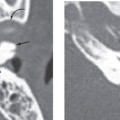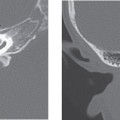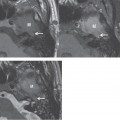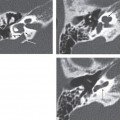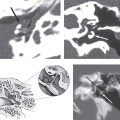CHAPTER 22 Cholesterol Granuloma
Epidemiology
Cholesterol granuloma, also called “cholesterol cyst” and “chocolate ear,” is an expansile, inflammatory mass of granulation tissue in the middle ear. The term cholesterol granuloma refers to its pathologic features, whereas cholesterol cyst describes its gross appearance. It develops as a result of obstruction that leads to a repetitive cycle of hemorrhage and granulation tissue formation. It is a foreign body reaction to cholesterol deposits that occur in obstructed fluid-filled air cells of the temporal bone. It can also occur in the petrous apex and mastoid air cells, but is more common in the middle ear.
There are two theories proposed to describe its occurrence. According to the classic “obstruction-vacuum” hypothesis, cholesterol granulomas form when there is mucosal swelling obstructing the circuitous pneumatic pathway. There is resorption of the gas in obstructed cells, creating relative vacuum and rupture of the blood vessels. Cholesterol granuloma forms from the anaerobic breakdown of the blood products. According to the “exposed marrow” theory, there is obstruction secondary to inflammation. This is due to budding of the mucosa in young adults that invades and replaces the hematopoietic marrow of the temporal bone. Hemorrhage from the exposed marrow coagulates within the mucosal cells and occludes the outflow pathway. This sustained hemorrhage provides the engine for progressive cyst expansion.
Clinical Features
Patients with cholesterol granuloma often have a history of purulent or serous otitis media and allergies. Young and middle-aged adults are usually affected. Distribution is equal for both sexes. Most patients have symptoms running for 2 to 3 years and present with slowly progressive conductive deafness. Unlike cholesterol granulomas of the petrous apex, there are no cranial neuropathies. On examination, there is bluish discoloration of the eardrum (“blue eardrum”). The growth pattern is variable and depends on the frequency of hemorrhages within the lesion over a period of time.
Pathology
Stay updated, free articles. Join our Telegram channel

Full access? Get Clinical Tree


